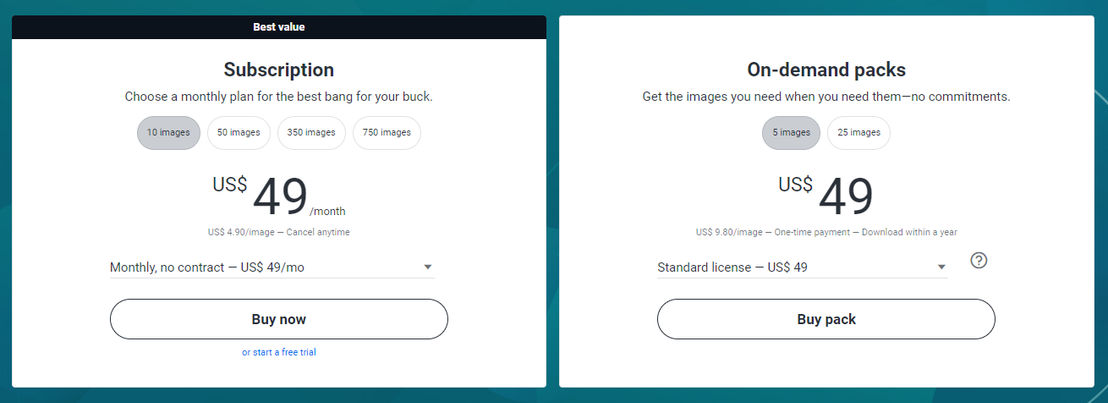Wondering how much you could earn from your photos on Shutterstock? You’re not alone! Shutterstock is one of the biggest platforms for photographers and stock image creators, but their payment system can seem a bit complex at first glance. Essentially,
Factors Influencing Shutterstock Photo Earnings

When it comes to how much you can earn per photo on Shutterstock, a few key factors come into play. Here’s a breakdown of what influences your earnings:
- Contributor Level: Shutterstock assigns levels based on your performance, starting from Standard to Elite. Higher levels unlock higher earnings per download, with Elite contributors earning the most.
- Download Type: Shutterstock offers different licensing options—Standard and Enhanced. Standard downloads typically pay less, while Enhanced licenses fetch higher payouts.
- Subscription vs. On-Demand Sales: Shutterstock makes money from subscriptions (monthly plans) and individual image purchases. The payout you receive depends on the type of sale.
- Image Quality and Relevance: High-quality, relevant images tend to get more downloads, translating to higher earnings. Keeping your portfolio fresh and aligned with current trends helps.
- Exclusive vs. Non-Exclusive Content: Exclusive contributors often earn higher royalties because they agree to sell their images only on Shutterstock, which can be more lucrative for both parties.
- Market Demand: Popular themes or niches—like business, technology, or lifestyle—are in higher demand, which can lead to more downloads and earnings.
Understanding these factors can help you strategize your contributions to maximize your income. Remember, building a strong portfolio, staying consistent, and choosing the right licensing options can make a significant difference in your Shutterstock earnings!
Understanding Shutterstock’s Contributor Tiers and Revenue Shares
If you’re thinking about contributing photos to Shutterstock, it’s important to get a good grasp of how their contributor system works. One of the key factors influencing how much you earn per photo is the contributor tier you’re in and the associated revenue share. Basically, Shutterstock rewards photographers differently depending on their sales volume and overall contribution history.
Shutterstock has a tiered system that includes:
- Standard Contributor
- Elite Contributor
- Exclusive Contributor (optional)
The Standard Contributor is where most new photographers start. At this level, you earn a base percentage of the sale price, which typically hovers around 15-30%, depending on your total downloads and whether you’re an exclusive contributor.
Once your portfolio hits certain milestones—like a specific number of downloads—Shutterstock may move you up to the Elite Contributor tier. This move usually means a higher revenue share, sometimes up to 30-40%, which is great news for those selling a lot of images.
For those who decide to go exclusive with Shutterstock—that is, only sell their images through Shutterstock—they often receive even better earnings. Exclusive contributors tend to get higher payout percentages and more promotional opportunities, boosting their earning potential.
How Does Revenue Sharing Work?
In simple terms, Shutterstock pays contributors a percentage of the sale price for each download. The exact percentage depends on your contributor tier and whether you’re exclusive or non-exclusive. Here’s a quick breakdown:
| Contributor Tier | Non-Exclusive Share | Exclusive Share |
|---|---|---|
| Standard | 15-20% | N/A |
| Elite | 30-40% | Up to 40% |
It’s worth noting that the more downloads you accumulate, the more you can increase your earnings per photo. Also, Shutterstock sometimes runs promotions or special deals that can temporarily affect payout rates, so it’s good to stay updated on their policies.
Why Your Contributor Tier Matters
Leveling up your contributor status isn’t just about bragging rights; it directly impacts your earnings. The higher your tier, the better your revenue share, which means more money per download. Plus, higher-tier contributors often get access to exclusive opportunities, such as featured placements or participation in special collections.
So, if you’re serious about earning more from your photos, focus on consistently uploading quality images, optimizing your keywords, and increasing your download count. Over time, this can help you move up the tiers and maximize your earnings on Shutterstock.
Average Earnings Per Photo on Shutterstock
Now, let’s talk about what you can realistically expect to earn per photo on Shutterstock. The truth is, earnings vary quite a bit depending on several factors like image quality, niche, keyword optimization, and your contributor tier.
On average, most contributors report earning between $0.25 to $2.00 per download. For each photo, the total earnings depend on how many times it’s downloaded. So, if a photo gets 100 downloads at an average earning of $0.50 per download, that’s a total of $50 from that single image.
Here’s a rough breakdown:
- Low-performing photos: Might earn just a few cents per download, especially if they’re niche or low-quality.
- Moderate-performing photos: Usually earn around $0.50 to $1.00 per download.
- Popular photos: Can generate $2.00 or more per download, particularly if they’re trending or highly sought after.
Keep in mind, your earnings per photo can increase if:
- You’re an exclusive contributor, which tends to offer higher payouts.
- Your portfolio includes images in high-demand niches like business, technology, or lifestyle.
- You optimize your keywords well, making your images easier to discover.
- Your images are of high quality and appeal to a broad audience.
Ultimately, earning a consistent income from Shutterstock involves building a diverse portfolio of high-quality images that appeal to buyers. Some contributors make a few dollars a month, while others earn thousands—it’s all about strategy, persistence, and understanding what sells best.
So, if you’re just starting out, don’t be discouraged by the numbers. Focus on creating great content, learn from your sales data, and gradually you’ll see your earnings grow. Remember, every download counts!
Tips to Maximize Your Income as a Shutterstock Contributor
Looking to boost your earnings on Shutterstock? You’re in the right place! Making the most out of your contributions isn’t just about uploading a bunch of images; it’s about strategic effort and smart choices. Here are some practical tips to help you maximize your income:
Focus on High-Demand Topics
Research what buyers are searching for. Trends change, so keep an eye on trending topics like technology, health, or seasonal themes. Use Shutterstock’s trending search data or tools like Google Trends to get insights. Creating images in popular categories increases your chances of sales and royalties.
Maintain Quality Over Quantity
It might be tempting to upload hundreds of images, but quality always wins. Well-composed, high-resolution photos with clear subject matter tend to perform better. Invest time in editing and ensuring your images are sharp, properly lit, and free of distractions.
Use Descriptive and Relevant Keywords
Keywords are your main way for buyers to find your images. Be specific and include relevant terms that accurately describe your photo. Avoid keyword stuffing—focus on quality keywords that match the content. Think about what someone searching for that image would type in.
Stay Consistent and Regular
Upload consistently. The more your portfolio grows, the higher the chances of your images appearing in searches. Set a schedule that works for you—whether it’s weekly or bi-weekly—and stick to it. Over time, this builds your reputation and visibility.
Participate in Shutterstock Contests and Promotions
Shutterstock often hosts contests or promotional campaigns. Participating can give your work extra exposure and sometimes even lead to bonuses or special recognition. Keep an eye on their contributor dashboard for opportunities.
Engage with the Community and Learn
Join forums, social media groups, or Shutterstock’s contributor community. Sharing experiences, tips, and feedback can help you learn new strategies and stay motivated. Also, review your sales data regularly to understand what works best and adapt accordingly.
Optimize Your Portfolio
- Remove or update underperforming images
- Add new images regularly to keep your portfolio fresh
- Ensure your best work is featured prominently
By applying these strategies, you’ll not only increase your sales but also build a strong, sustainable income stream as a Shutterstock contributor. Remember, patience and persistence are key—success doesn’t happen overnight, but with consistent effort, the rewards can be significant!
Comparison of Shutterstock Payments with Other Stock Photo Platforms
Wondering how Shutterstock stacks up against other stock photo platforms in terms of earnings? Let’s break down the differences so you can make informed decisions about where to upload your best work.
Shutterstock
As we’ve discussed, Shutterstock offers a tiered royalty system based on lifetime earnings and contributor level. Typically, you can earn between 20% to 30% per sale, with higher percentages available as your earnings increase. The platform also offers bonuses, exclusive content opportunities, and a large customer base, which can lead to steady income if you keep uploading quality content.
iStock operates on a contributor-exclusive and non-exclusive model, with royalty rates ranging from 15% to 45%. Exclusive contributors earn higher royalties, but they agree to sell only through iStock and Getty. The platform is known for higher-paying assignments and a dedicated customer base, especially for premium images.
Adobe Stock pays contributors a flat rate of 33% per license for photos, illustrations, and vectors. Since Adobe Stock is integrated into Adobe Creative Cloud apps, it benefits from a large user base of creative professionals. The simplicity of the royalty rate makes it easier to estimate potential earnings, and the platform tends to favor high-quality, unique images.
Depositphotos offers royalty rates that vary from 30% to 34% based on your sales volume. They also provide flexible licensing options and a straightforward payout system. The platform is popular among beginners because of its user-friendly interface and decent earnings potential.
Premium platforms like Getty Images and Alamy tend to pay higher royalties, often between 30% to 60%. However, acceptance is more selective, and the submission process is more rigorous. If you can get your images accepted here, the payoffs can be substantial, especially for exclusive, high-quality content.
Summary Table
| Platform | Typical Royalty Rate | Exclusive Option | Notes |
|---|---|---|---|
| Shutterstock | 20-30% | No | Large volume, steady income potential |
| iStock | 15-45% | Yes/No | Higher royalties for exclusives, premium content |
| Adobe Stock | 33% | No | Integrated with Adobe apps, large user base |
| Depositphotos | 30-34% | No | Good for beginners, straightforward payments |
| Getty Images | 30-60% | Yes | Selective acceptance, high payout potential |
Ultimately, the best platform for you depends on your niche, quality of work, and willingness to commit to exclusivity. Many successful contributors diversify across multiple platforms to maximize their income potential. So, consider your goals, upload consistently, and choose the platforms that align best with your style and ambitions. Happy shooting and earning!
Conclusion and Final Thoughts on Shutterstock Photo Payments
Understanding how much Shutterstock pays for a single photo is essential for photographers looking to monetize their work effectively. The platform offers a flexible royalty system that varies based on several factors, including your exclusive status, your total lifetime earnings, and the licensing type purchased by customers. Typically, contributors earn between 25% to 40% of the sale price, with exclusive contributors often earning higher royalties. It’s important to note that earnings can fluctuate depending on the complexity and demand for your images.
To maximize your income, focus on creating high-quality, niche-specific images that are in demand. Utilizing relevant keywords and tags can also improve your photos’ visibility, leading to more downloads and higher earnings. Remember, building a strong portfolio and maintaining consistency can help you increase your sales over time. Additionally, understanding the royalty structure and how different licensing options impact payouts will enable you to strategize your submissions better.
While Shutterstock provides a steady income opportunity, success largely depends on the quality of your photos, your marketing efforts, and your ability to adapt to market trends. Keep exploring new ideas, stay updated on platform policies, and consistently upload fresh content to grow your earnings. Ultimately, with dedication and strategic planning, Shutterstock can become a lucrative platform for your photography career.
In summary, knowing the payout structure and optimizing your contributions can help you make the most of Shutterstock’s earning potential. Stay informed, stay creative, and continue improving your craft to maximize your earnings on this popular stock platform.


